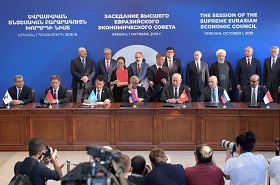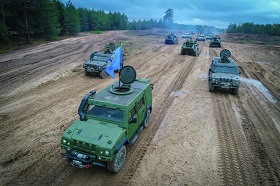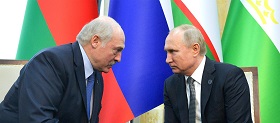The development of the Eurasian Economic Union in 2019 was once again marked by deepening integration and the expansion of global trade and economic relations. Emerging trends include the improved quality of integration and the shaping of the Union as a pragmatic and responsible partner involved in international relations as an independent actor.
The EAEU is improving its institutions and mechanisms for regulating trade and economic cooperation, reducing the number of barriers to ensure the complete freedom of movement of goods, services, labour resources and capital within the single customs space of the member states.
The EEC estimates that the dynamics of mutual trade in comparable prices (calculated using the physical volume of supplies index) demonstrate stable trade volumes, remaining at the 2018 level, and a drop in prices of 1.5 times, which led to a decrease in the cost indicator of mutual trade volumes. Consequently, the Eurasian integration factor retains its positive effects and can be bolstered by stepping up integration processes.
The potential of expanding trade cooperation can be realized by expanding the circle of partners in the preferential regime of economic cooperation. In 2019, the EAEU continued its work to develop international cooperation. One example of this is the Agreement on Trade and Economic Cooperation between the Eurasian Economic Union and the People’s Republic of China, which went into force in 2019. Cooperation agreements were signed with Serbia and Singapore, memorandums on cooperation were signed with Indonesia, and a partnership declaration was signed with the Pacific Alliance. In addition, negotiations were launched on agreeing on the terms and conditions of partnership agreements based on previously signed memorandums of cooperation with the African Union, Bangladesh, Argentina, the United Nations Economic and Social Commission for Asia and the Pacific, the World Intellectual Property Organization and the Global Medical Device Nomenclature Agency.
The EAEU’s activity in the international arena is testimony to its great development potential and the recognition of the Union as an independent actor in international relations.
The development of the Eurasian Economic Union in 2019 was once again marked by deepening integration and the expansion of global trade and economic relations. Emerging trends include the improved quality of integration and the shaping of the Union as a pragmatic and responsible partner involved in international relations as an independent actor.
The EAEU is improving its institutions and mechanisms for regulating trade and economic cooperation, reducing the number of barriers to ensure the complete freedom of movement of goods, services, labour resources and capital within the single customs space of the member states.
The following regulatory instruments have been amended and improved in 2019:
- electronic customs declarations have been put into use; these declarations are connected to the unified information platforms currently being developed in all EAEU states;
- the procedure for offsetting customs duties using a system of advance payments has been modified (it will significantly speed up paperwork flow and reduce customs clearance times);
- the rules for calculating and collecting compensatory and anti-dumping duties have been streamlined;
- the terms and powers of state agencies have been specified; the areas of influence and regulatory control of the Eurasian Economic Commission (hereinafter the EEC) have been expanded in matters relating to the supervision and implementation of the EAEU anti-monopoly rules both on cross-border markets and throughout the EAEU in general;
- international treaties have been amended in the part pertaining to the distribution of customs duties collected between the treasuries of the member states (the following ratio has been stipulated: Armenia – 1.22 per cent; Belarus – 4.86 per cent; Kazakhstan – 6.955 per cent; Kyrgyzstan – 1.9 per cent; Russia – 85.065 per cent).
Emphasizing the “Digital” Aspect
In 2019, the EAEU actively developed and improved the digital agenda in various segments of the common market. Projects for implementing a digitalization programme have been developed and approved. The programme stipulates the procedure for implementing digitalization projects through the consolidated efforts of all EAEU members.
In particular, in order to simplify the paperwork flow, speed up customs proceedings, and make it easier to do business in the Union, the EAEU adopted the decision to streamline the rules and functioning of the “one window” system. For all the members of the EAEU market, this could serve as a platform for an electronic information exchange system for all EAEU market participants regardless of their country of origin, as well as a venue for interacting with the licensing and regulatory system.
The EAEU also adopted the Concept of Cross-Border Information Interaction, which lays down the legal framework for the exchange of information among EAEU market participants and can be used as a platform for the development of the information services market in the future.
The digital agenda programme also extends to the real sector of the economy, which is provided for by the project for industrial cooperation, sub-contracting and technology transfer. The project entails developing a system of e-contracts between industrial enterprises. The advisory body, the Industrial Policy Council, has been tasked with managing the implementation of this project.
Single Sectoral Markets
2019 saw the adoption of the Concept for the Creation of a Common Financial Market of the Eurasian Economic Union, which entails free mutual access to national markets for banking and insurance institutions (regulating the process of streamlining and aligning the rules and mechanism for issuing licenses and their mutual recognition). The Concept will boost competition on the banking services and insurance markets, expand the range of available financial services, and stimulate investment and capital mobility.
The complexity and scale of reforms necessary to create common banking, insurance and securities markets require a lengthy preparatory period in order to coordinate, streamline and aligning macroeconomic criteria, standardize indicators to ensure the stability of the financial and insurance sectors, as well as the legislative framework, by 2025. A transitional model of the common financial market will subsequently be launched.
Energy is Key
The transitional model of the EAEU common energy market has been launched. An important detail in the concepts of energy market integration is the fact that, when negotiations on the Union Treaty were in progress, the objective of creating a single common market for all types of energy sources was abolished in favour of creating the common market format (CEM) as a target objective for the integration of the energy sector.
The EAEU CEM entails free pricing on energy and energy transmission using the following mechanisms: long-term contracts between independent companies use agreed prices set with due account of the equilibrium price of the common market that has been written into contracts, and exchanges operate with free pricing.
Trade is organized with the use of an e-system for swap contracts, forwards and futures, and with the use of the Single Information System (SIS) accessible for all wholesale market participants. However, only authorized organizations are authorized to conclude long-term transactions and determine the volumes of surplus energy offered for bidding.
Before launching the gas market, the upper and lower price limits for surplus electricity and service tariffs are to be regulated within internal prices. This means that the “freedom” of pricing for energy and services is from the very outset established in accordance with the terms and conditions and within the limits of the manufacturing, resource, technical and technological potential of national natural monopolies, and the common market only adjusts pricing depending on the current supply and demand at a specific moment in time.
This is a transitional format for the functioning of the EAEU CEM, and it fits perfectly into the integrational model of cross-border trade cooperation, which entails achieving the objectives set for the common market by increasing trade volumes and ensuring equal access to the services and infrastructure of national monopolists.
Consequently, the development of Eurasian integration made it possible to preserve the growth of the positive influence that integration has on the stability of the macroeconomic situation in member states and on the degree of macroeconomic convergence in the EAEU in 2019. As a result of applying the single customs tariff of the Customs Code of the EAEU and expanding the list of technical regulations implemented by all states, conditions on the commodities markets are becoming streamlined at a rapid pace, and equal competition conditions are being created for all actors on the EAEU common market. These developments make it possible to stem the drop in growth rates that were predicted for the global market at the beginning of 2019.
Streamlining the rules governing trade in goods and services on the common EAEU market in 2019 made it possible to ensure a smaller drop in mutual trade in monetary terms within the Union compared to the decline in foreign trade with third countries. The decrease in bilateral trade in January–September 2019 was 1.3 per cent, compared to the 2018 trade decline of 2.5 per cent with third countries.
Armenia (6.4 per cent) and Belarus (3.5 per cent) demonstrated positive growth in mutual trade, while the other states demonstrated a decrease in trade turnover of approximately 3 per cent on average. As in previous years, minerals (26 per cent of the total mutual trade in the EAEU), machinery, equipment and vehicles (20 per cent, with Russia and Belarus remaining the principal suppliers), agricultural raw materials (15 per cent), metals and metal goods (13 per cent), and chemicals (12 per cent) remained the principal drivers of growth.
The EEC estimates that the dynamics of mutual trade in comparable prices (calculated using the physical volume of supplies index) demonstrate stable trade volumes, remaining at the 2018 level, and a drop in prices of 1.5 times, which led to a decrease in the cost indicator of mutual trade volumes. Consequently, the Eurasian integration factor retains its positive effects and can be bolstered by stepping up integration processes.
The potential of expanding trade cooperation can be realized by expanding the circle of partners in the preferential regime of economic cooperation. In 2019, the EAEU continued its work to develop international cooperation. One example of this is the Agreement on Trade and Economic Cooperation between the Eurasian Economic Union and the People’s Republic of China, which went into force in 2019. Cooperation agreements were signed with Serbia and Singapore, memorandums on cooperation were signed with Indonesia, and a partnership declaration was signed with the Pacific Alliance. In addition, negotiations were launched on agreeing on the terms and conditions of partnership agreements based on previously signed memorandums of cooperation with the African Union, Bangladesh, Argentina, the United Nations Economic and Social Commission for Asia and the Pacific, the World Intellectual Property Organization and the Global Medical Device Nomenclature Agency.
The EAEU’s activity in the international arena is testimony to its great development.








